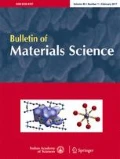Abstract
A chalcolithic (2350-1800 BC) copper chisel from Balathal has been characterized by X-ray diffraction, microstructural and electrochemical methods. The surface patina was composed of sulfates and oxysulfates in the outer layers while the inner layers were rich in copper oxides. The chisel exhibited smaller grain sizes near two of the surfaces while the structure in the interior was equiaxed. The deformed grains and inclusions near the surfaces and variation in the microhardness of the sample from different faces proved that the copper chisel was processed by cold deformation after initial casting of the square cross-section chisel. The electrochemical behaviour of chalcolithic Cu has been compared with that of a modern Cu sample by potentiodynamic polarization studies. The corrosion rate of chalcolithic Cu in aerated 3.5% NaCl solution was only marginally higher than that of modern Cu. The higher rate of corrosion has been attributed to the presence of second phase sulfide inclusions. The excellent condition of preservation of the 3800-year-old copper object, with no indications of stress corrosion cracking, suggests that pure copper or copper-based materials can be seriously considered as candidate canister materials for long-term underground storage of nuclear wastes in underground repositories.
Similar content being viewed by others
References
ASTM 1987Metals test methods and analytical procedures, Annual Book of ASTM Standards, Volume 3.02, Section 3, Philadelphia, USA
Balasubramaniam R, Mungole M N, Prabhakar V N, Sharma D V and Banerjee D 2002Man and Environment 36 89
JCPDF 2001 Powder Diffraction Files,PCPDFWIN Software, Joint Committee on Powder Diffraction Standards — International Centre for Diffraction Data, Swarthmore, USA
Laha T, Shankar J, Balasubramaniam R, Tewari A, Prabhakar V N, Sharma D V Banerjee D 2002Indian Journal of History of Science 37 20
LaQue F L 1975Marine corrosion-causes and prevention (New York: John Wiley). 6
Leygraf C and Graedel T 2000Atmospheric corrosion (New York: Wiley-Interscience) 140–148
Misra V N, Shinde V, Mohanty R K, Dalal K, Mishra A, Pandey L and Kharakwal J 1995Man and Environment 20 57
Misra V N, Shinde V, Mohanty R K, Pandey L and Kharakwal J 1997Man and Environment 32 35
Rosborg B, Karnland O, Quirk G and Werme L 2003 inProceedings of the international workshop on prediction of long term corrosion behaviour in nuclear waste systems (Cadarache, France: European Federation of Corrosion) 412–423
Trethewey K R Chamberlain J 1988Corrosion for students of science and engineering (Harlow: Longman Scientific) p. 92
Wranglen G 1969Corros. Sci. 9 585
Author information
Authors and Affiliations
Rights and permissions
About this article
Cite this article
Srivastava, A., Balasubramaniam, R. Material characterization of ancient Indian copper. Bull Mater Sci 26, 593–600 (2003). https://doi.org/10.1007/BF02704321
Received:
Revised:
Issue Date:
DOI: https://doi.org/10.1007/BF02704321




